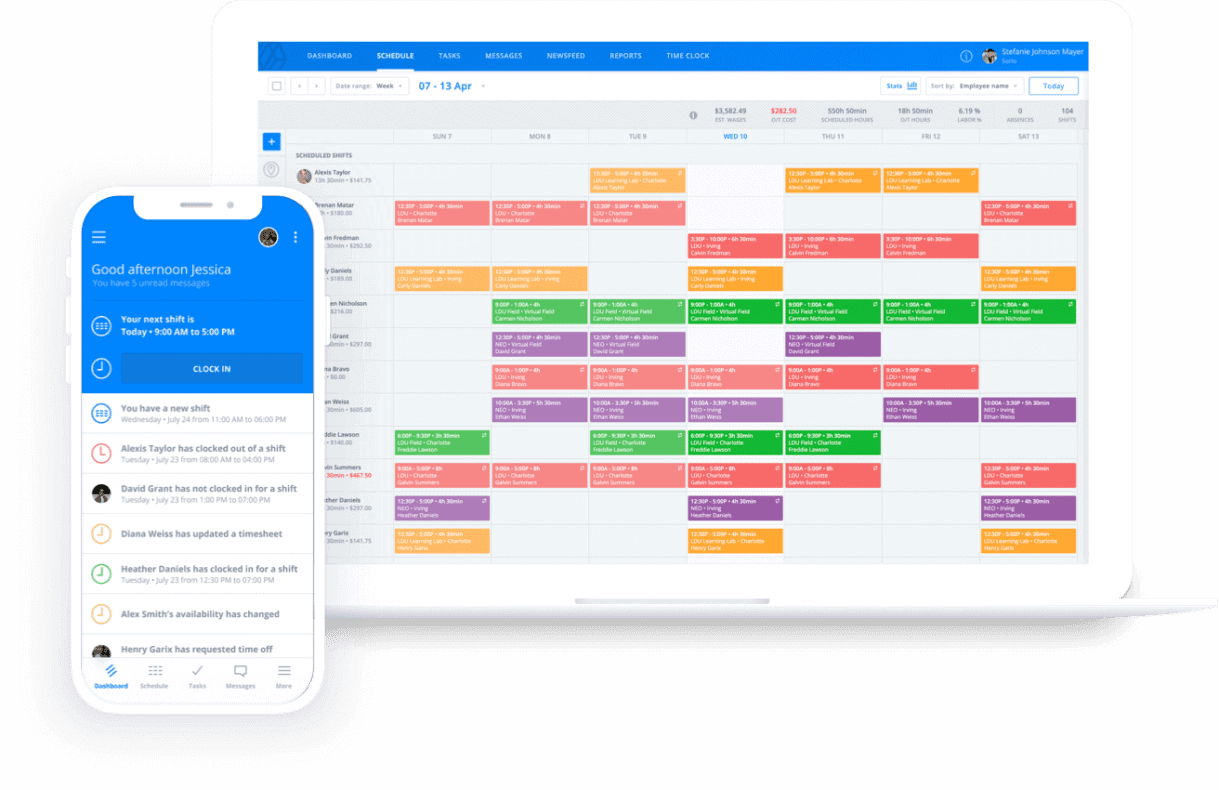How To Use Workplace Personality Tests To Boost Productivity
Conducting a workplace personality test is a fun, unique, and effective way to b...

Want to understand your employees better? Want to tailor your motivation tactics to keep everyone working at 100 percent? The answer is simple: learn which types of employees are on your team.
No, we’re not talking nationality, age, gender, experience, and the like (that’s more about diversity). When we refer to “type” in this case, we’re referring to dominant personality traits. So how can you identify the types of employees in your business? The management experts at Sling are here to help.
In this article, we’ll show you 16 personality types based on the research of Carl Jung and Isabel Briggs Myers and tell you how to motivate each.

Before we begin, it’s essential to clarify that the names for these types do not necessarily indicate the job the employees must hold. Instead of trying to line up personality types with job titles, focus on the types of employees on your team and learn how to motivate each.
Architects are strategic thinkers who stick to the facts and are most comfortable when they make a plan and follow it step by step.
Motivate Architects by giving them opportunities to work on their own on long-range projects.
Inventors enjoy theories and ideas. Their biggest passion is turning those theories and ideas into reality. Inventors have little desire to lead and will only follow others if it’s in their own best interest.
Motivate Inventors by giving them the opportunity to be creative and to come up with something completely new.

Commanders are driven, assertive, and outspoken. They prize efficiency and organization above all else and know how to find solutions to complex problems.
Motivate Commanders by giving them opportunities to lead. It doesn’t even have to be leading others at first. Commanders often excel at public speaking, so it can be something as simple as giving those types of employees the chance to make a presentation.
Visionaries get very excited about new projects but then lose interest in the routine aspects of seeing the project to completion. Visionaries are often vigorous debaters and may get carried away with always being right.
Motivate Visionaries by telling them it can’t be done (they’ll want to prove you wrong). Then step back and give them free rein to solve the problem.
Advocates often serve as the protector within a group. They are extremely intuitive and concerned about the feelings of others.
Motivate Advocates by showing them how their jobs benefit others and then challenging them to find a way to help.

Mediators are interested in serving humanity rather than themselves and are more concerned with personal growth than external rewards. They’re loyal, adaptable, and laid-back.
Motivate Mediators by tapping into their creative mind and then pushing them to find an alternative approach to the problem.
Leaders exhibit outstanding people skills and are often externally focused with a real concern for how others think and feel. Their primary motivation is serving others.
Motivate Leaders by letting them work with others whenever possible. Show them how their work affects the lives of those around them.

Free Spirits are open-minded, enthusiastic, flexible, and creative. They often have a broad range of interests and abilities and are excited by new ideas (but bored with details).
Motivate Free Spirits by helping them see how what they do matters and makes a difference. Listen to their feelings and concerns, and then allow them to find their own way to achieve an objective.
Inspectors are thorough and responsible with a well-developed ability to concentrate. They are typically interested in upholding established systems rather than creating new ones.
Motivate Inspectors by helping them see that they have a big responsibility in making the project a success.
Protectors are quiet, kind, and perceptive of others’ feelings. They are stable, practical, and value traditions or novel systems.
Motivate Protectors by showing them that you are relying on them to get the job done and that you trust they will do their best.

Administrators are not interested in theory or abstract ideas unless they can see how it applies to the task at hand. Administrators are practical, organized, and like to be in charge.
Motivate Administrators by encouraging them to take on managerial roles and responsibilities. In the short term, give them a list of clear, tangible outcomes so they can see what they have to do.
Providers are warm-hearted with a strong sense of responsibility and duty toward others. They are often the caregivers in the group.
Motivate Providers by showing them how their job will improve the circumstances of others. In the job itself, provide plenty of structure and organization so they can see their way through to the end.
Experimenters are interested in how and why things work and are good at finding solutions to practical problems.
Motivate Experimenters by challenging them to find a quicker, better way to improve the system or get the job done.
Artists are always ready to explore and experience something new. They do not like conflict and are more focused on enjoying the present moment rather than looking to the future.
Motivate Artists by encouraging them to be creative.
Entrepreneurs are the action-oriented people in the group. They don’t need long explanations but would rather just get right to work.
Motivate Entrepreneurs by focusing on immediate results. With an Entrepreneur, it’s pretty much about giving them a challenge and then letting them go.
Entertainers live for the moment. Their enjoyment is contagious and makes things more fun for others. Entertainers are people-oriented with well-developed common sense and practical skills.
Motivate Entertainers by highlighting the fun of the task and the rewards that completing it will bring.
The purpose of identifying the types of employees on your team is not to discriminate — remember, it takes all kinds to be successful.
Use this information to get your employees working on jobs that are a fit for their personality type and to find new ways to motivate your team. When you do that, you’re on your way to making your business the best it can be.

We gave you a specific way to motivate each employee type according to the way their personality works.
In this section, we’ll offer activities and business practices you can use to motivate all the employee types on your team at the same time.
Some activities will be more appealing to certain areas of the spectrum, but they’re all excellent ways to motivate, engage, and inspire your team to greatness.
Whether it has two employees or two hundred, every business needs a clear hierarchy of responsibility. If an employee has to get approval from a superior, she should know who that person is.
What’s more, the hierarchy should be set and not constantly shift from one manager to the other. This makes everything clear to the employee and doesn’t create confusion about which manager to approach for each problem.
This business practice will appeal to the more logical employee type on your team, but everyone will benefit from a bit more organization.
For tips on creating an effective hierarchy of responsibility, check out his article from the Sling blog: What Is An Organizational Chart And Why Does Your Business Need One?
An aggravation box (or frustration box) is the opposite of a suggestion box. If you adhere to a strict anonymity policy, employees will feel free to vent their concerns.
As a manager, then, you can get some deep insights into the problems your employees face. So, encourage them to write down their frustrations, and even provide a suggestion for how to fix it if they have one.
This will appeal to the problem-solver employee type, but, again, everyone can benefit from finding ways to improve the way your business works.
Whether it’s every week or once a month, get your team together and hold a brainstorming session.
Bring a problem (something from the aggravation box?) and let your employees throw out ideas for solutions. This will bring each employee type — from one end of the spectrum to the other — in alignment with your strategy and help them feel like they’re making an impact.

The simple act of eating together can have a profound effect on how each employee type feels about their coworkers and on the motivation, unity, and overall effectiveness of the team.
Consider gathering together once a week for a group meal. You could have food brought in for lunch, make it yourself if you run a restaurant, or have everyone contribute a dish.
If you’d like to get out of the office, go to a nearby pub or gather in a park for tasty snacks and upbuilding conversation.
Work is important, but sometimes, getting out of the office is equally as important. Consider organizing an office outing to break the routine and give your team the opportunity to get to know each other in a more social setting.
Paintball and Laser Tag make for fun team-building exercises and can be a great way to burn off excess office stress.
Each employee type will have a different way of looking at, approaching, and handling problems. Those different perspectives provide plenty of opportunity for innovation.
In most cases, your employees are the best source of innovation because they are intimately familiar with the processes under which they work.
Allowing team members to try new things — and then implementing those innovations into the workflow when they succeed — keeps your employees looking for better ways to get things done.
This benefits you, your team, and the business as a whole by creating constant improvement. Encourage and support innovation by recognizing and rewarding those who do so.

Building a diverse team means taking into account two very important variables: employee type (their personality) and employee background (their culture and viewpoint).
When it comes to personality, hiring a majority of ENFJs or ISFPs will give your business strength in that particular area but will create weakness in all the other areas. For best results, assemble a team of diverse personalities so your business has strength in all areas.
When it comes to background, remember that business is becoming more global every day. Hiring team members from a variety of backgrounds gives your business access to those markets like never before.
Diversity — in both employee type and background — also empowers your team to feel like they have the tools necessary to broaden their horizons and push your business into new territory.
Excitement at encountering new challenges and setting new goals can have a hugely positive impact on the way your team works together.
Games of any kind are a great way to motivate the various employee types, forge bonds, and build camaraderie among your team.
Take time out to play a few rounds of Pictionary or Trivial Pursuit. Set up a TV and a Nintendo 64 and play some old-school Mario Kart. If you want to get outside the office for an hour, organize a game of kickball.
There are so many different kinds of games you can play with your employees that we can’t list them all here. But, for more suggestions, check out these articles from the Sling blog:
Work can become routine and uninspiring when employees do the same things over and over every day.
To remedy this, give your team “stretch assignments” that allow them to step outside their comfort zone, try something new, and give them a challenge to conquer.
This could be leading a team meeting or heading up a new project. Whatever it is, it should push the employee to improve their dominant employee type — or even expand into a non-dominant area — and not just be a rehashing of what they normally do.
Motivating each employee type can be as simple as defining your company’s purpose. This purpose shifts the focus from the WHAT and the HOW of your business to more firmly shine a light on WHY your business does what it does.
It also gives your employees something bigger to look at than just the process or the product that they work with every day.
For more on giving your business and your team direction and purpose, check out these articles from the Sling blog:

At the most basic, motivating each employee type depends a great deal on communication.
It doesn’t matter if that communication revolves around scheduling, inventory, clocking in and out, ethics, or customer service. The better you communicate with your employees the more engaged they’ll be.
We developed the Sling app to streamline communication and make your work life easier.
Sling is a suite of tools that makes scheduling, tracking labor, finding substitutes, assigning tasks, and building employee engagement extremely simple. And that’s just the tip of the iceberg.
For an all-in-one solution to help you improve your workforce management and optimization, incorporate the Sling suite of tools into your workflow.
Features include:
Add to that Sling’s onboard artificial intelligence and you’ve got an extremely beneficial and flexible set of tools that will help you harness the strengths of the different employee types, get control of your team, increase engagement, and improve the way they work.
There are so many ways Sling can help improve your business that we don’t have room to talk about them here. So instead of reading about it, why not try it out? Sign up for a free account and see for yourself how Sling makes work better.
For more free resources to help you manage your business better, organize and schedule your team, and track and calculate labor costs, visit GetSling.com today.
See Here For Last Updated Dates: Link
This content is for informational purposes and is not intended as legal, tax, HR, or any other professional advice. Please contact an attorney or other professional for specific advice.
Schedule faster, communicate better, get things done.